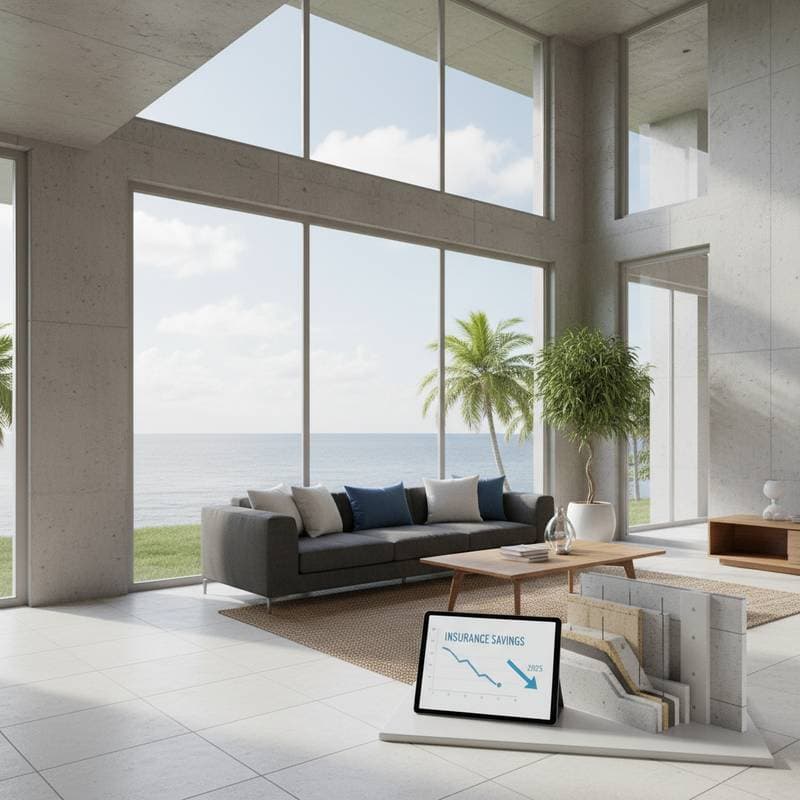Hurricane-Resistant ICF Homes Deliver 2025 Insurance Savings
Picture yourself in the heart of your home as intense rain lashes the windows. Winds howl outside, yet the structure remains unshaken, lights flicker not, and the interior maintains serene calm. This sense of security defines insulated concrete form (ICF) construction. The author gained this appreciation while assisting a friend in reconstructing after a severe coastal storm. Observing the superior durability of her ICF residence compared to neighboring wood-framed dwellings transformed perspectives on resilient building practices.
Vulnerabilities of Conventional Homes in Severe Storms
Homeowners in coastal or high-wind zones face annual anxiety during hurricane seasons. Standard wood framing, though cost-effective initially, exposes structures to destructive wind forces and airborne projectiles. Even fortified masonry can fracture or displace under prolonged storm assault. Recovery extends beyond physical repairs to include insurance filings, interim accommodations, and prolonged emotional strain.
Insulated concrete forms (ICF) alter this dynamic fundamentally. Construction involves stacking interlocking foam panels, reinforcing with steel, and pouring concrete to create monolithic walls. The resulting insulated barrier withstands wind, moisture, and impacts while optimizing energy use.
Core Advantages of ICF Construction
Opting for an ICF home yields more than structural integrity. It delivers enhanced livability, operational efficiency, and enduring worth. The integrated foam insulation minimizes drafts and stabilizes internal climates. The solid concrete foundation dampens external noises, creating tranquil interiors even amid urban or windy environments. During a personal stay in an ICF dwelling amid a summer tempest, the absence of typical creaks and vibrations proved remarkably soothing.
Insurers increasingly recognize these attributes. Properties exhibiting proven defenses against wind and flood pose reduced liabilities. Such features frequently result in premium reductions. In select areas, certified resilient constructions qualify for discounts via regional or federal programs.
Key Performance Features of ICF Homes
Examine the elements that render ICF homes exceptionally effective and conducive to insurance incentives.
- Superior Wind Resistance: ICF walls, when engineered correctly, endure winds exceeding 200 miles per hour. The seamless concrete matrix counters uplift and torsional forces that compromise roofs and facades in standard builds.
- Enhanced Impact Durability: Multi-layer foam exteriors cushion collisions from debris like tree limbs or roof tiles. The assembly preserves integrity without penetration or deformation.
- Robust Water Repellence: Concrete and foam combinations resist decay, distortion, or microbial growth post-flooding. Surfaces facilitate rapid drying, averting long-term degradation.
- Optimized Energy Performance: High R-values in ICF walls slash heating and cooling requirements by up to 50 percent, yielding substantial utility savings.
- Effective Acoustic Isolation: Dense materials attenuate sounds from vehicles or gales, fostering peaceful living spaces.
These attributes collectively reassure insurers, translating to tangible cost reductions for owners.
Evaluating Costs and Building Processes
Initial ICF outlays surpass traditional framing by approximately 5 to 10 percent, varying by project scale and site conditions. Returns materialize swiftly through diminished premiums, reduced energy outlays, and minimal maintenance. Many owners recoup the premium within three to five years.
Building proceeds efficiently. Teams assemble foam blocks on-site, embed reinforcement bars, and pump concrete into voids. Forms remain as permanent insulators post-curing. Suppliers offer workshops for regional contractors, enabling local expertise. Projects for moderate-sized homes often complete the structural envelope in two to four weeks.
Exterior and interior finishes mirror conventional options. Apply brick, stucco, siding, or cement boards externally; install drywall over embedded furring strips internally. The concealed concrete reinforces without altering aesthetic choices.
Essential Steps for ICF Home Development
Prospective builders benefit from structured preparation to ensure seamless execution.
- Engage Knowledgeable Architects: Select professionals versed in ICF dynamics to leverage thermal and seismic benefits in designs.
- Review Building Regulations: Identify incentives like tax credits or grants for fortified constructions in storm-prone locales.
- Invest in Resilient Openings: Specify impact-resistant glazing and fortified frames for windows and doors to match wall performance.
- Incorporate Airflow Systems: Integrate mechanical ventilation to maintain freshness in highly sealed envelopes, supporting health and efficiency.
From hands-on involvement in a modest ICF endeavor, the author recommends precise concrete handling tools, such as extended-reach floats, to achieve flawless wall surfaces. Consistent mixtures enhance both aesthetics and longevity.
Accessing Materials and Expertise Locally
Coastal distributors stock ICF components from established manufacturers like Nudura, Fox Blocks, and Logix. These providers maintain robust logistics and technical assistance for installers. Collaborate with nearby concrete firms to calibrate mixes for optimal strength and set times.
Prospective owners should tour completed ICF projects for tangible evaluation. Experiencing the solidity and hush firsthand dispels doubts and highlights practical merits.
Securing and Maximizing Insurance Discounts
Premium adjustments depend on carrier policies and geographic risks. Documented ICF features often unlock reductions of 10 to 30 percent. Combine with elements like fortified roofs and shutters for compounded benefits.
Consult agents early in planning. Submit specifications on wall dimensions, load capacities, and compliance certifications. Insurers reference approved resilient techniques to verify qualifications.
Everyday Benefits of ICF Living
ICF residences demand little upkeep. Walls resist settling and fissuring, while steady temperatures eliminate seasonal extremes. Lower humidity curbs allergen buildup, simplifying cleaning routines. Employ basic tools, like extendable dusters, to preserve pristine conditions effortlessly.
Steps Toward Resilient Coastal Ownership
Transitioning to ICF construction fortifies homes against escalating storm threats while optimizing finances. Homeowners who prioritize these methods enjoy enhanced safety, efficiency, and value. Consult experts today to initiate a build that withstands 2025's challenges and beyond.
